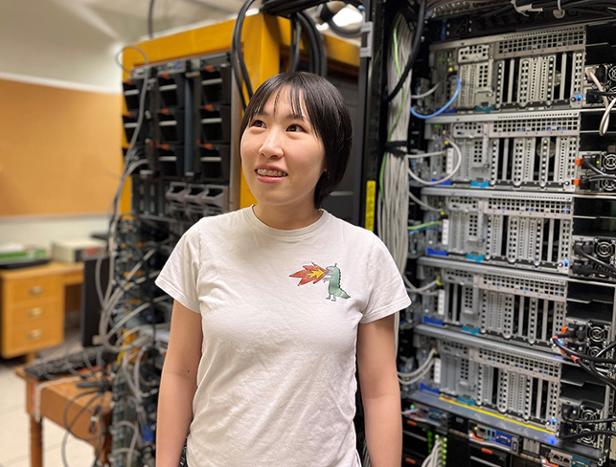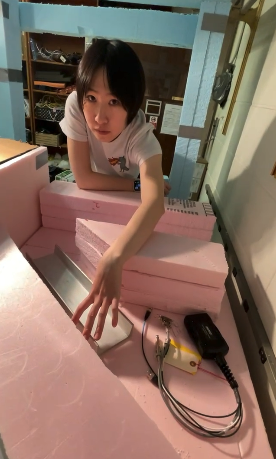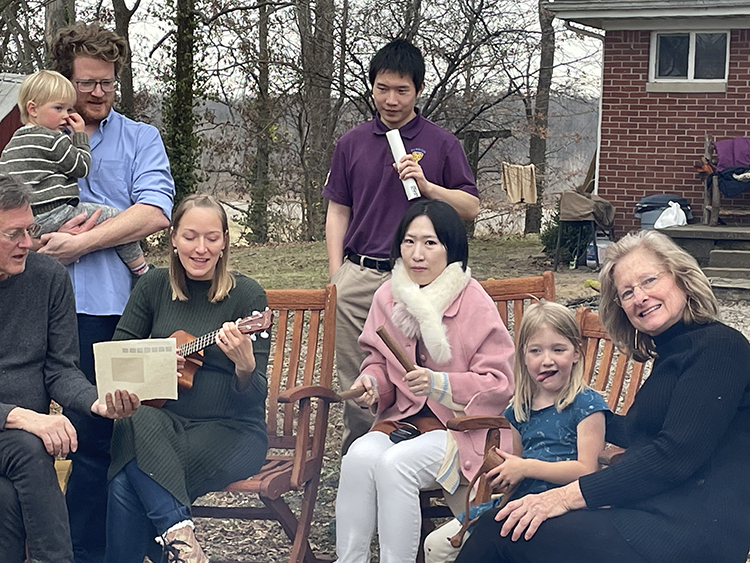
Student Spotlight: Jijun Chen
Taking the next giant leap into particle physics with tenacious Mu2e research
Story by Cheryl Pierce

Jijun Chen, a PhD student with Purdue Physics and Astronomy, knew from an early age that she wanted to be a scientist. She moved around the world to take her studies to a new level at Purdue University. Her research and thesis involve the Mu2e (Muon to electron) experiment at Fermilab National Accelerator Laboratory. The project is a search for Charged Lepton Flavor Violation at the level of 1 part in 1017. Jijun, who goes by JJ, is working on her thesis, “Normalization of the Charged Lepton Violation Experiment.” She mainly focuses on simulating the particle reaction in the Mu2e experiment, which will eventually lead to more extensive experimentation at Fermilab (beginning in 2025).
“My research is about finding a lepton flavor number violation (non-conservation) process,” she explains. “There are some particles that never undergo strong interaction. The first particle they found in this category is an electron, which has light mass. They call these kinds of particles lepton. Lepton literally means ‘light’. Later, they found muon, tau particle and their corresponding neutrino that also belong to these lepton family. People found these family members always show up together in the process by some way, they called it as lepton flavor conservation. It is just like energy and momentum conservation; people always want to find some conservation in some process. My research focuses on finding charged lepton-flavor number violation (non-conservation) process.”
JJ’s research experiment will search for Beyond-the-Standard-Model, the neutrinoless conversion in the field of an aluminum nucleus, which is the Charged Lepton Flavor Violation (CLFV) process, with a single event sensitivity surpassing the current world’s best limit by 10,000 times. Her thesis delves into the difficult process of counting the 1017 observed muons expected in the experiment… the experiment is sensitive to 1010 muon decays per second. This is the equivalent of more decays in a second than heart beats a person would have if they lived 300 years!
“To report a reliable result, the number of stopped muons will be normalized to 10% precision utilizing a combination of two 𝛾-ray and one x-ray transitions,” she says. “The first, directly proportional to the CLFV signal is the 1808.7 keV 𝛾-ray emitted promptly in the muon capture process. The second, is the 346.8 keV x-ray emitted promptly from the 2p→1s muonic atomic transition in Al, from muon stops in the target. The third, is the 844 keV 𝛾-ray from the 𝛽-decay. The stopped-muon rate measurement will use two complementary photon counting detectors. One of them, the LaBr3 detector, is capable of high-rate operation up to and above 800 kcps, with 0.7 % energy resolution. The other, the HPGe detector is capable of energy resolution of 0.1%, however, its rate capability is limited to an estimated ∼100 kcps.”
JJ is responsible for the design, modeling, and protection of the detector system used to count this very large number of muon decays. She has also given a public talk, “APS Division of Particles & Fields (DPF), July 12-14th 2021: Normalization of the Mu2e Charged Lepton Flavor Violation Experiment.” AdditIonally, she is an author of two publications involving Mu2e:
- “arXiv, October 20, 2022: Mu2e Run I Sensitivity Projections for the Neutrinoless µ − → e − Conversion Search in Aluminum “https://arxiv.org/pdf/2210.11380.pdf
- “arXiv, October 5th 2021: Muχe - A Search for Familons in Muon Decay Using HPGe Detectors https://arxiv.org/abs/2110.02164”.
She has made two presentations at the American Physical Society meetings regarding these publications. Last year she wrote 10 internal Mu2e technical notes and made weekly presentations to the Fermilab Stopping Target Monitoring Group, the Slow Controls Group, and participated in the Collaboration meetings.
JJ is also involved in experimental physics. She has performed two test beam experiments at the Helmholtz Zentrum Dredsen Rosendorf Laboratory in Germany. Due to the pandemic, there was no travel options, so JJ’s tenacity shined through as she set up her experimentation remotely.
She is advised by Dr. David Koltick, who is a Professor of Physics and Astronomy, the Director of the Applied Physics Laboratory, and Coordinator of the Center for Science and Technology at Purdue University. According to him, the remote experimentation was quite difficult but highly successful.
“The laboratory was excited to have a remote experiment to prove that even during the pandemic the laboratory could continue to operate and produce physics,” says Koltick. “Jijun was up to the demands being responsible for the data collection and working with the machine operators and technicians, to install the experiments, talking them through, how to operate the experiments, collect the data and preforming data checks, all remotely. No small task!”
Before coming to Purdue, she was a gifted scientist but wasn’t well versed in the science of particle physics. She says Professor Koltick is very patient with students and suggests reading materials and experimentation that will help them be more versed in the science. She said he treats his students like family and will have the whole lab group out to his family farm. “Professor Koltick is very patient person with sense of humor,” she says. “Around the bonfire, we would share our funny stories or meaningful memories in our life.”

According to Koltick, JJ is, “an exceptional student in both her understanding of the theoretical and experimental aspects of elementary particle physics. During her time in our group, she has shown her deep excitement of physics. On the theoretical side, when she first joined the group, she demanded to have a reading course in theoretical physics in order to learn how to calculate elementary particle reaction rates starting from basic principles; meaning starting from Feynman Diagrams. Of course, her studies were excellent. And again, at the start of the pandemic, when the university was shut down, she demanded that I teach a course on Standard Model Gauge Theory. I agreed and to my surprise 24 Purdue physics graduate students from around the world wanted to participate. The course was very exciting as what better way to spend our time locked down than to study such a beautiful physics topic.”
JJ was born and raised in Shenzhen, China. It is the southernmost place in China and she describes the weather as being very much like Miami, Florida. She completed her bachelor’s degree in Shenzhen and packed up to come to the United States for graduate school… Miami University. Miami University is nothing like Miami, Florida.
“Before I came here, I went to Miami University, it has a confusing name because it is in Oxford, Ohio. I received my master’s degree in physics there. The first winter I was in Ohio, I thought I couldn’t survive the coldness. West Lafayette is pretty much like Ohio: corn, cold, they are like brother and sister states.”
After she gets her PhD with Purdue, JJ has big plans. She hopes to stay in the United State and would like to work with projects involving Artificial Intelligence and how it applies to an aging population. Then, when not tackling the not-so-small problem of curing the curse of aging, she’d like to write a novel in her spare time. If anyone can accomplish these goals, it’s JJ Chen. This Boilermaker is using every opportunity at Purdue to make her own giant leaps in the scientific field.
I think Purdue is much like a fertile soil that if you work harder, you can gain more,” she says. “I think behind each one's progress is hard-work and sacrifice. I know I will miss Purdue very much when I leave.